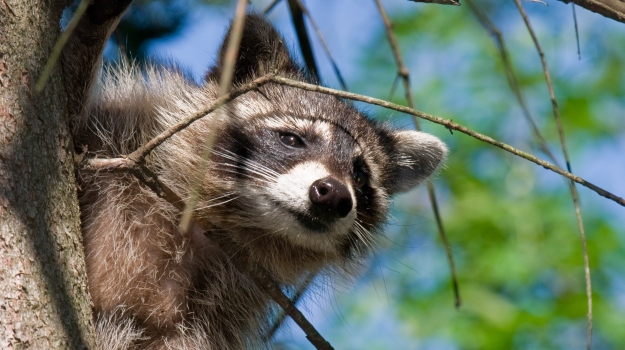
These Bandits may be Stealing your Hunting Season
Removing this Menace will Improve Wildlife Numbers
By Matt Dye
All avid hunters and landowners know the three basics for growing and holding most wildlife on their property: food, water, and cover. Improvement to the habitat usually results in increases to the quantity and quality of the game species using the property. But, what do you do when your land has great habitat, year-around food sources, plenty of water and your wildlife numbers still are not increasing like you dreamed? The answer could be trapping! Consistent trapping will likely permit ground nesting birds (quail, turkeys, etc.) and deer populations to increase, allowing your land to demonstrate more of its potential, just like you dreamed.
I had the unique opportunity while going to college to earn additional class credit during the fall of 2011 by completing an internship with Dr. Grant Woods. I was required to complete an independent study set up by my college professor with a project designed by Dr. Woods and me that focused on a specific aspect of wildlife management. As we developed the project, I asked Dr. Woods about his goals for his “Proving Grounds” - his own 1,500 acre ranch in southwest Missouri. One of his objectives was to increase his turkey population. On this highly managed parcel Dr. Woods had developed productive year-around food plots, great nesting habitat, acres of mature oaks, and reliable water sources. Even with all of these habitat components working in the wildlife’s favor, the turkey population wasn’t very high.
The next step that would allow the turkey population to begin to increase towards the land’s carrying capacity was to become serious about trapping. Dr. Woods and his family have trapped for the past eight years, capturing many different species of predators. I, however, would now focus solely on catching as many raccoons as possible during the fall of 2011.
With a large population of predators on a property, it is very difficult for ground nesting bird populations to prosper. Raccoons are opportunistic feeders, so if they smell food they will follow the scent to find the source. If a raccoon finds a turkey nest, past research has shown they help themselves to an easy meal. Not only will they devour the eggs, but they may even kill the hen turkey. This predation reduces future turkey populations by decreasing the potential hatch and brood stock. This is the same for quail, grouse, ducks and pheasants across the United States. If you are not a bird hunter, but instead you value your deer herd, then listen up because trapping predators applies to you as well!
A large boar raccoon is one of the meanest, nastiest creatures in the woods. Raccoons can cause an immense amount of stress to a deer herd. If you use trail cameras to monitor-survey or on bait sites, you will most likely document raccoons frequently visiting the sites you established for deer. Raccoons are very aggressive towards deer and will even run off mature bucks from bait locations. Just like humans, deer exert energy while under stress and during times of high anxiety.
When antlers are growing during the summer excess nutrition that isn’t utilized by a buck’s body systems is directed toward growing antlers. When a buck uses energy stressing over raccoons there is less left over to be used for growing antlers.
During the late spring a young fawn is just as vulnerable to a large boar raccoon as the hen on her nest. Large male raccoons can easily weigh in excess of twenty pounds. If a large raccoon comes across a six pound fawn it’s probably not going to pass the defenseless meal. If there’s a twenty pound raccoon taking on a six pound fawn, my money is on the raccoon every time. Trapping is a great tool to reduce the number of raccoons and create more favorable balance between this predator and several prey species.
Considering the importance of managing predators, my findings will not only help you become a better woodsman, but also a better wildlife manager.
Much of this data could not have been collected without the help of the Duke Trap Company. I used two of their trap types: a cage trap design and a dog-proof style trap. These two traps can be inexpensively purchased but are still extremely effective at catching raccoons. The aspect that I liked best about the dog-proof style trap is that it is “target specific.” Whether you are trapping 2,000 or 20 acres you do not have to worry with catching your neighbor’s beloved pet. It’s because the design of the trap does not allow a dog to steal your bait or trip the trigger. A Duke dog-proof trap can be placed anywhere you desire, and they’re not time consuming to set.
Once you have a trap set, how can you attract raccoons to the site? I’ve found inexpensive dog food works well. Dry dog food is easy to bait your traps with, and can be spread around the trap site to attract the attention of the raccoon to your set. One last hint: cover your dog-proof trap with a metal can. This will stop crows from stealing your bait, but raccoons have absolutely no problem flipping off the can to work your trap. This will increase your catch rate, while not wasting a precious "trap night” because the bait has been stolen.
If you do not have ample time to spend trapping target I would suggest concentrating your efforts during the new moon. From my experiences, as well as Dr. Woods’, more raccoons are caught during periods when the moon is in a specific range of illumination. I went back through Dr. Woods’ data and checked the moon illumination for dates that he had caught raccoons. I found that although each phase of the moon was represented and successful, a strong trend was found during the new moon.
Roughly 36% of the raccoons trapped over the past eight seasons, were taken with less than 12.5% of the moon’s surface illuminated. When the moon’s surface is illuminated for less than 12.5%, only 27% of a full lunar cycle, then the 36% catch rate during this time becomes more substantial. This trend proves true across years of trapping and many different weather patterns.
The moon has a strong correlation with raccoon movement. If your time to trap is limited, then wait for the “prime-time” to set out your traps, look in the forecast for the new moon. The data suggests that this is the best time for successfully trapping raccoons.
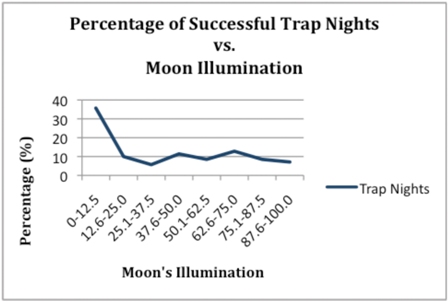
Using the data collected from the first four weeks of the fall 2011 trapping season and comparing it to Dr. Woods’ past data, I was able to depict how consecutive years of trapping the same property for raccoons changes their age structure. Dr. Woods’ data suggest the majority of raccoons, both male and female, ranged from 10.1 to 15 pounds. With most adult raccoons weighing between 12 to 20 pounds, Grant was continually taking adult raccoons each year, but what has changed since January of 2004?
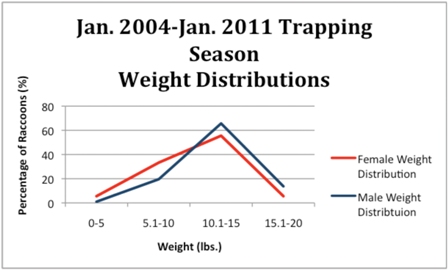
During my time spent trapping the Proving Grounds, my data collection revealed that something within the raccoon population was changing. I was trapping more raccoons that weighed less, and also had a broader range of raccoon weights than the previous years’ data. As I tried to understand and diagnose the reasoning for the change, it finally hit me! After years of trapping raccoons, a “void” was left on the property. This meant that since Dr. Woods had trapped the long-time resident raccoons that called his property home, I was now trapping the younger raccoons that were attempting to fill the “void.” The young raccoons we filling the spaces created by removing the older resident raccoons. This was great news for a younger trapper like me. I was having the opportunity to trap young raccoons that had not been educated yet.
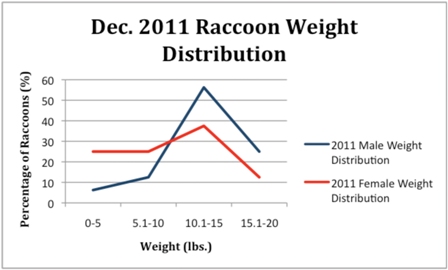
This was even better news for Dr. Woods and wildlife managers like himself. Trapping reduces the number of predators that will be present during the fawning/nesting season. However yearly trapping is a must, because raccoons will fill this void by the following fawning/nesting season. If your state regulations allow it, trap just before these times, this only ensures a better survival rate for your turkey and deer.
Another bit of data that supported my theory that the demographics of the resident raccoon population was changing due to trapping was the change in the sex ratio of trapped raccoons. Just like in most animal populations, females control the population size. As shown on the graph below (Yearly Raccoon Catch), sex ratio of raccoons trapped on Dr. Woods’ property has changed. I only trapped a few mature females. With the sex ratio of trapped raccoons changing to favor males, it seems the resident raccoon population has been decreased and young males are dispersing into the property annually. This is encouraging news for Dr. Woods and his goal of increasing the number of turkey poults and fawns that survive!
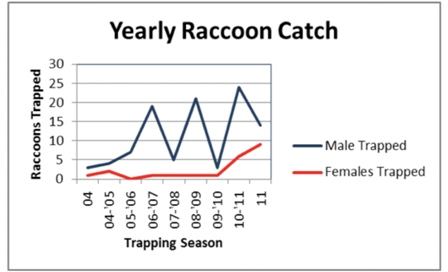
What stands out in the chart above (Yearly Raccoon Catch) is that the number of trapped male raccoons far outweighs the number of females. The main reason for this is the timing of Missouri’s trapping season -it is within the raccoon mating season. Boar raccoons will travel far and wide in search of a mate. When they travel further they are more likely to come in contact with traps. This is why year after year a large number of males are caught. Although they will show up each year, if trapped just prior to or during the nesting and fawning season there will be less predation of turkey poults and fawns.
Trapping for several years in a row will allow managers to reduce predator numbers on any property. My data suggests that there will be a reduction in resident populations and younger raccoons will attempt to “fill the void.”
Raccoons are ferocious predators. If left alone these omnivores can, and will, eat turkey eggs and add stress to your deer herd. They can cause considerable damage to your treasured hunting ground.
Don’t over look trapping. It is an important management tool. Ignoring this tool probably means more resources spent on other aspects of your wildlife management program. It may take a few years to eliminate the majority of the larger raccoons. However, trapping is a valuable management tool. The skills and knowledge I learned while trapping, such as reading sign, etc., have made me a better deer hunter. Managing to improve the quantity and quality of deer and turkey on your property and consider trapping your property today.
Header image credit: Leisa Hennessy | Dreamstime.com






























